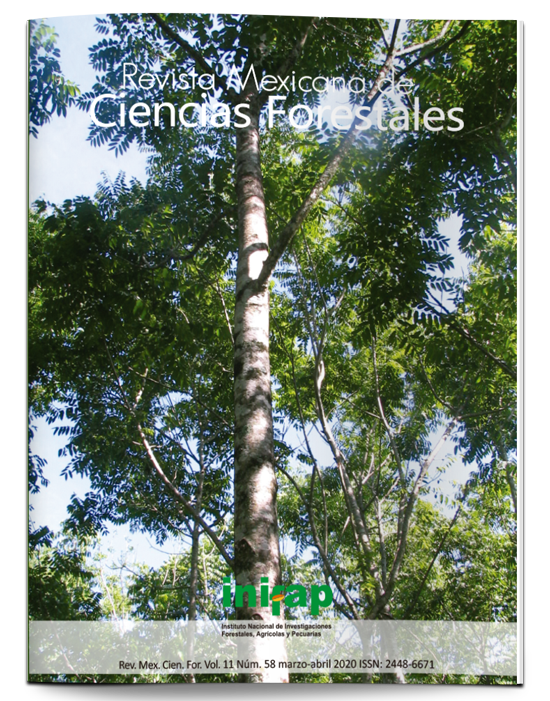Arboreal vegetation of the Cerro Tres Puntas de Pilasca, (Salas-Motupe), Lambayeque, Perú
DOI:
https://doi.org/10.29298/rmcf.v11i58.549Keywords:
Basimetic area, seasonally dry forest, diametric distribution, floristic diversity, floristic structure, LambayequeAbstract
From March to June, 2018 the seasonally dry forest Cerro Tres Puntas of Pilasca (Salas-Motupe, Lambayeque, Perú) was studied, in order to obtain information on its structure and its floristic composition. In a linear transect, about 11.4 ha, specimens of woody plants with DBH ≥ 5.0 cm were assessed. 410 individuals representing 17 species, 17 genera and 10 families were recorded. The most abundant species were Vachellia macracantha (Fabaceae 154 individuals) and Celtis iguanaea (Cannabaceae 55 individuals). The families with the highest number of species were Fabaceae (7) and Malvaceae (2). The basimetric area was 343.86 m2 ha-1 highlighting Ficus obtusifolia with 139.23 m2 ha-1 and Beilschmiedia sulcata with 120.90 m2 ha-1. The Importance Value Index for the species reached the main values in F. obtusifolia (49.34), V. macracantha (46.75) and B. sulcata (41.57), while the Family Value Index was widely higher in the Fabaceae family (111.86). While these results show that this forest is a precarious version of the region’s, F. obtusifolia individuals between 35-39.9 m high and 210-219.9 cm DBH were found. This study will help to accomplish an efficient conservation and reforestation program in order to improve the Cerro Tres Puntas forest, located in one of the poorest areas of the nation.
Downloads
Published
How to Cite
Issue
Section
License
The authors who publish in Revista Mexicana de Ciencias Forestales accept the following conditions:
In accordance with copyright laws, Revista Mexicana de Ciencias Forestales recognizes and respects the authors’ moral right and ownership of property rights which will be transferred to the journal for dissemination in open access.
All the texts published by Revista Mexicana de Ciencias Forestales –with no exception– are distributed under a Creative Commons License Attribution-NonCommercial 4.0 International (CC BY-NC 4.0), which allows third parties to use the publication as long as the work’s authorship and its first publication in this journal are mentioned
The author(s) can enter into independent and additional contractual agreements for the nonexclusive distribution of the version of the article published in Revista Mexicana de Ciencias Forestales (for example, include it into an institutional repository or publish it in a book) as long as it is clearly and explicitly indicated that the work was published for the first time in Revista Mexicana de Ciencias Forestales.
For all the above, the authors shall send the form of Letter-transfer of Property Rights for the first publication duly filled in and signed by the author(s). This form must be sent as a PDF file to: ciencia.forestal2@inifap.gob.mx
This work is licensed under a Creative Commons Attribution-Noncommercial 4.0 International license.






